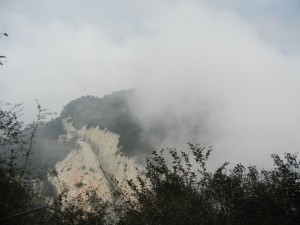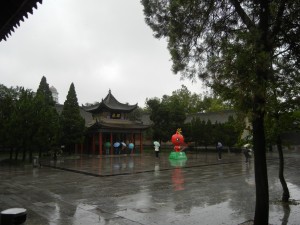Many traditional cultures structure their thought around the 4 cardinal directions. Ancient China did too, but it added ideas to this perspective, and created a blend that’s uniquely Chinese.
From the steaming Yangtze River to unearthly mountains (like Hua Shan, pictured above), China’s huge land inspired its ancients to add more ideas to the conceptual framework that they unified themselves with. These ideas are still very much alive.
Many scholars have noted the importance of wind (feng) in ancient China. David N. Keightley wrote that it had become a key idea by the late Shang Dynasty (1200-1045BCE).
Feng had a wide range of meanings–it wasn’t just the movement of air masses, but also the prevailing mood that swept over the land. It was also associated with power in general. Each cardinal direction had the power to send fortune or disaster (in the form of a violent storm, a drought, or an invading army, or deadly animal). People could conveniently associate this power with wind. But why was wind a more central concept in Shang China than in other cultures from that time?
Many communities in China were tightly knit settlements of farmers, and northern China often suffered from droughts and floods. So, Shang kings frequently conducted divination to predict wind and rain. Ancient Egypt relied entirely on the Nile’s flow, so wind and rain weren’t important. The composers of the Rg Veda, who created much of Ancinet Indian culture, emerged from a nomadic culture roaming through vast Central Asia, and they structured their thoughts according to gods and metaphysical energies that flowed freely–they didn’t as tightly structure them into 4 directions (Vayu was a deity of the wind, but he was one of many gods). So, farming communities in ancient China more easily conflated the importance of wind and rain with the powers of the 4 directions.
Wind remained an important concept in later dynasties. Keightley wrote that people in the Zhou Dynasty still thought that land was populated with weather-making powers that brought wind and rain. Unlike Egypt and most of India, China has harsh winters–it’s easy to feel that wind and rain accompanied by the cold have powers that are destructive. I was sure feeling the cold when I took the above picture in Xi’an. Those folks under the pavilion weren’t in shirt sleeves either.
Keightley wrote that wind was an important concept in ancient Chinese medical theory. Many texts warn that wind is one of nature’s most dangerous forces, and they give long lists of maladies that wind causes.
Many conceptual systems that became central by the Han Dynasty, such as yin-yang, the I-Ching, and the meridians in acupuncture, are based on the idea that change is basic in nature–rather than the static ratios and geometric shapes ancient Greeks focused on. These changes happen in cycles that flow smoothly. The smooth circulation of patterns of energy throughout the whole system became the most common model of reality. People by the Han dynasty applied this model to many types of systems, including the body, the state, and nature as a whole. The smooth flow of yin and yang patterns also became a key idea in landscape painting, and in the discipline of fengshui, which ensures that a building is in harmony with the yin and yang energies in the land.
The light and misty (yin) areas in the Qing Dynasty vase above smoothly alternate with the denser (yang) forms, and the whole scene softly rolls, and encompasses all of nature. Nothing stands out as a distinct object. The perspective is of the whole, and the whole flows smoothly and cyclically.
This focus on the smooth circulation of energies throughout the whole system was applied to many fields because it already had deep roots. People by the late Shang Dynasty blended their concern with wind and rain with concepts of the 4 cardinal directions. This mixture became a seedbed for ideas that Chinese culture still emphasizes. Like Indian thought, Chinese thought has very ancient roots.
And they still nourish modern Chinese art.






Comments on this entry are closed.